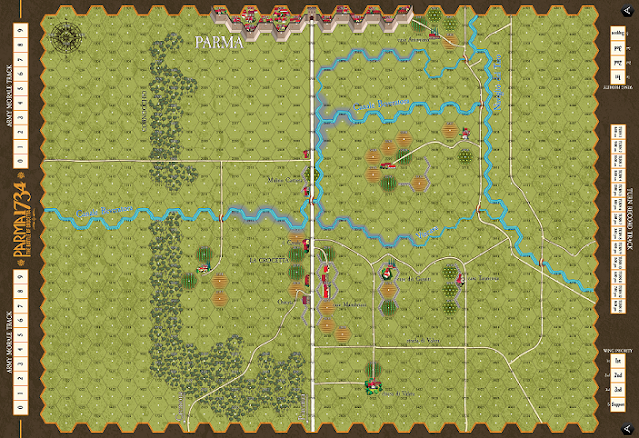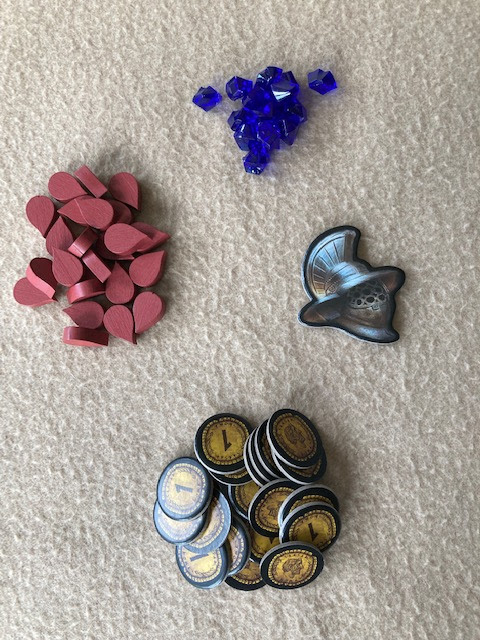Parma 1734 The Battle of Crocetta
by
Aleph Game Studio
The Eighteenth Century was as full of warfare as the preceding centuries in Europe. We mostly think of these two wars: The War of the Austrian Succession, and The Seven Years War, up until the Wars of the French Revolution. There were, however, quite a few wars that erupted, two of them being The War of Jenkin's Ear, and The War of the Polish Succession. The Battle of Crocetta was part of the War of the Polish Succession. It was fought near Parma on June 29th 1734, between the Austrian Army, and the Franco-Piedmontese Army. France and Austria had been fighting over Italy for hundreds of years and would continue until 1859. The French were originally commanded by Marshal Claude Louis Hector de Villars (of The War of the Spanish Succession fame), but he gave up the ghost on June 17th 1734. The French were then commanded by Marshals de Broglie, and Coigny. The Piedmontese were commanded by King Carlo Emanuele III of Savoy. The Austrians were commanded by Marshal Claudio Florimondo di Mercy, and Prince Federico Luigi of Wurttemberg-Winnetal. The battle was very hard fought, and both sides suffered higher than normal casualties given the amount of troops on the battlefield. The Austrians withdrew after the battle, giving the French a dubious victory. So, let us see what is in the box:
1 game map
3 countersheets
6 scenario cards
2 player aids
1 10-sided die
1 rulebook
Players: 2
Time: 2-5 hours
The map is done very well with some really nice touches added for the buildings on it. There are no ambiguities about what a hex consists of etc. The counters are large at just under 3/4", and they also come pre-rounded. Each one has what is really a small artwork done it to differentiate between infantry, cavalry, artillery, and leaders. The Movement Allowance and all of the numbers on them are nice and big for old grognard eyes. There is one Player Aid for each player, so no need to share one. It has the Terrain Chart, Infantry Fire Table, Artillery Fire Table, Shock Combat Table, and the Sequence of Play on each. Their are six Players' Aid sheets for the setup of both scenarios. These are in full color, and instead of just a list of what counters go where it shows the actual counter full sized on the sheets. This is a really nice touch. All of the Players' Aids' are made of hard stock. The Rulebook is twenty-eight pages long. It is in full color, and uses large print throughout its pages. An altogether very well manufactured game.
This is the Sequence of Play:
"1. Command Phase
During this phase the players organize their army.
Both players:
• simultaneously assign their Priorities of Order to
the Army for the current turn;
• check the status of the Troop Command;
• place reinforcements as indicated in the
Scenario Cards.
2. Opening Artillery Fire Phase
In this phase the players use their artillery
batteries. Players take turns firing one battery at
a time. The rules of the Scenario usually indicate
who is the first player of the phase, otherwise
each side rolls a die and whoever gets the
highest result will be the first. In the event of a tie,
both players roll the die until one of the two gets
a higher result than the other. The winner will
become the Active player and will activate his
first artillery battery.
3. Initiative Phase
In this phase is the players determine who will be
the Initiative Player. The players each roll a dice,
the player with highest result die roll is the
Initiative Player for the current turn, while the
other will be the Reactive Player. In the event of
a tie, both players roll the die until one of the two
gets a higher result than the other.
4. Wing Impulse Phase
In this phase, players take turns activating their
Wings, based on how they distributed the Order
Priorities during Phase 1.
This is the sequence that is carried out within this
phase:
a) Impulse of the Initiative Player (1st action):
the Initiative Player reveals and activates his
own Priority Wing in this sequence:
1. Movement of units
2. Activated units Fire Combat
3. Activated units Shock Combat
4. Mandatory moves caused by Shock
Combat
5. Advance after Shock Combat
b) b) Reactive Player Impulse (1st action): the
Reactive Player reveals and activates their
Priority Wing in this sequence:
1. Movement of units
2. Activated units Fire Combat
3. Activated units Shock Combat
4. Mandatory moves caused by Shock
Combat
5. Advance after Shock Combat
c) Other impulses: repeat the same sequence
as the previous impulses for the other Wings,
in order of priority assigned:
1. Initiative Player's Impulse (2nd flanking
action)
2. Reactive Player Impulse (2nd flanking
action)
3. Initiative Player's Impulse (3rd flanking
action)
4. Reactive Player Impulse (3rd flanking
action)
5. Impulse of the Initiative Player (support)
6. Reactive Player Impulse (support)
5. End of Turn Phase
During this phase, end of turn checks are
performed. In particular, this sequence must be
respected, starting with the Initiative player:
1) Check the Army morale (see 12.0);
2) Rally of units (see 13.0);
3) Remove 1st Shoot/1st Volley/Fired markers.
Finally, the Game Turn Marker is advanced."
I wanted to include the full Sequence of Play so that the gamer sees that this game does not use a simple cut and paste set of rules from other games series. It is a deep game that tries, and succeeds, in simulating eighteenth century warfare.
The scenarios that come with the game are:
1. Tutorial: Clash Of The Vanguards (8-10 AM)
2. The Battle Of Crocetta
The game has unusual Victory Conditions as well. The designer understands that eighteenth century warfare was not usually a battle to the death, or even a battle to one side being routed. So, the game's intent is for each side to force the other to fall to 10% of its Initial Morale Value. This then forces the side that hits that percentage to order a General Withdrawal Order. These are the values etc. of the two sides:
French/Piedmontese Army:
Initial Value - 88
Demoralization - 44
Withdrawal - 8
Austrian Army:
Initial Value - 96
Demoralization - 48
Withdrawal - 9
Demoralization causes an army to suffer its movement capacity halved, leaders to lose 1 point of Command Range, and all Discipline checks suffer a +2 modifier to the die roll.
Each separate regiment also has its own Regimental Breaking Point Value. This is a rule that is not often seen in games.
This a breakdown of some of the chrome added into the game:
Infantry can be in either:
Line
Column
There are four different types of Cavalry:
Heavy Cavalry
Cuiraissers
Dragoons
Hussars
Artillery can be either:
Limbered
Fire Capable
Leaders have a Command Range
The designer knows that divisions were not used at this time in warfare, and battles were fought by 'Wings'.
The game is a very taut see saw battle between two pretty evenly matched armies. The rules were designed to put the player into the shoes of a Marshal of the period. This means each player needs to learn the limitations of warfare at this period. The only thing missing from the rules are ones about sending dispatch riders out to your formations. Thank you Aleph Game Studio for letting me review this great and very interesting game from your stable. If a player is looking for a detailed engrossing game about eighteenth century battlefields they need look no further.
Robert
Aleph Game Studio:
Aleph Game Studio – A new beginning in gaming
Parma 1734: The Battle of Crocetta:

















































Follow Us